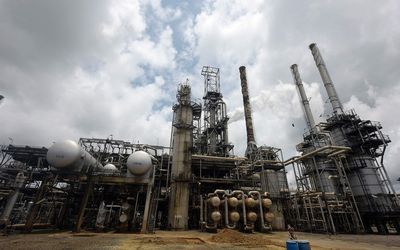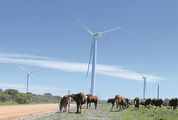Oil prices gain as IEA says it sees production cuts
by Libby George,
2016-03-11 17:54:25.0
LONDON — Brent crude was on track for its third weekly gain on Friday, supported by an optimistic report from the International Energy Agency (IEA) that said the market may have reached its bottom.
Still, analysts cautioned that a large glut of oil remained, with Goldman Sachs warning that US crude could saturate storage in the coming months.
US crude futures were trading at $38.79 a barrel at 2.43pm GMT, up 95 cents from their last close, having hit a 2016 high of $38.96 earlier in the day.
Brent crude futures were at $40.85 a barrel, up 80 cents, and on track for their third weekly gain in a row.
Both contracts were trading more than 45% higher than the lows of earlier this year.
The IEA said in a monthly report that oil might have bottomed and that low prices were beginning to impact crude output outside producer organisation the Organisation of the Petroleum Exporting Countries (Opec).
"There are clear signs that market forces ... are working their magic and higher-cost producers are cutting output," the Paris-based IEA said.
The group, which coordinates energy policies of industrialised nations, said it believed non-Opec output would fall by 750,000 barrels per day (bpd) in 2016, from its previous estimate of a 600,000 bpd decline.
It also said Iran’s post-sanctions return to exporting was happening more gradually than expected, keeping its barrels from putting significant pressure on the market.
Still, Iran said this week it would not participate in any output freeze until it had regained market share.
Industry sources also told Reuters on Friday that oil resumed pumping from Iraq’s Kurdistan to the Turkish port of Ceyhan. The pipeline’s closure in mid-February had taken some 600,000 bpd out of the market.
But there could be further supply disruption in the coming months, with a source telling Reuters on Friday that maintenance on Britain’s Buzzard oilfield in July would close it for roughly a month. The field produces about 180,000 bpd and is the largest contributor to the Forties crude oil stream, one of four crudes which underpin Brent.
The IEA said it nevertheless saw global oil and product stocks rising heavily in the first half of 2016, in the range of between 1.5-million and 1.9-million bpd, but that would slow to 0.2-million bpd in the second half. The excess itself led some to warn that a premature price recovery could hamper market rebalancing.
"We reiterate our view that oil prices need to remain low for longer, as the oil and capital market rebalancing are only beginning," Goldman said in its report.
Reuters

Port Harcourt refinery in Nigeria. Picture: AFP
LONDON — Brent crude was on track for its third weekly gain on Friday, supported by an optimistic report from the International Energy Agency (IEA) that said the market may have reached its bottom.
Still, analysts cautioned that a large glut of oil remained, with Goldman Sachs warning that US crude could saturate storage in the coming months.
US crude futures were trading at $38.79 a barrel at 2.43pm GMT, up 95 cents from their last close, having hit a 2016 high of $38.96 earlier in the day.
Brent crude futures were at $40.85 a barrel, up 80 cents, and on track for their third weekly gain in a row.
Both contracts were trading more than 45% higher than the lows of earlier this year.
The IEA said in a monthly report that oil might have bottomed and that low prices were beginning to impact crude output outside producer organisation the Organisation of the Petroleum Exporting Countries (Opec).
"There are clear signs that market forces ... are working their magic and higher-cost producers are cutting output," the Paris-based IEA said.
The group, which coordinates energy policies of industrialised nations, said it believed non-Opec output would fall by 750,000 barrels per day (bpd) in 2016, from its previous estimate of a 600,000 bpd decline.
It also said Iran’s post-sanctions return to exporting was happening more gradually than expected, keeping its barrels from putting significant pressure on the market.
Still, Iran said this week it would not participate in any output freeze until it had regained market share.
Industry sources also told Reuters on Friday that oil resumed pumping from Iraq’s Kurdistan to the Turkish port of Ceyhan. The pipeline’s closure in mid-February had taken some 600,000 bpd out of the market.
But there could be further supply disruption in the coming months, with a source telling Reuters on Friday that maintenance on Britain’s Buzzard oilfield in July would close it for roughly a month. The field produces about 180,000 bpd and is the largest contributor to the Forties crude oil stream, one of four crudes which underpin Brent.
The IEA said it nevertheless saw global oil and product stocks rising heavily in the first half of 2016, in the range of between 1.5-million and 1.9-million bpd, but that would slow to 0.2-million bpd in the second half. The excess itself led some to warn that a premature price recovery could hamper market rebalancing.
"We reiterate our view that oil prices need to remain low for longer, as the oil and capital market rebalancing are only beginning," Goldman said in its report.
Reuters
























Change: 0.40%
Change: 0.47%
Change: -0.49%
Change: 0.53%
Change: 1.03%
Data supplied by Profile Data
Change: 1.71%
Change: 1.28%
Change: 0.40%
Change: 0.00%
Change: 1.64%
Data supplied by Profile Data
Change: -1.27%
Change: 0.00%
Change: 0.05%
Change: -0.08%
Change: 0.35%
Data supplied by Profile Data
Change: -0.02%
Change: 0.21%
Change: -0.06%
Change: 0.53%
Change: 0.70%
Data supplied by Profile Data